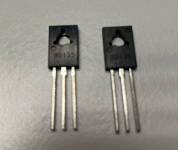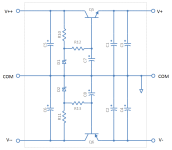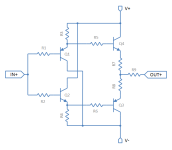Folks:
I’ve used BD135 and BD136 transistors to build unity gain preamplifiers (specifically, the B-buffer design by RJM Audio) for several projects. I recently had a moment of weakness on AliExpress.com, where I found BD135 and BD136 transistors at a price that is about 10% of their cost from a reliable supplier (e.g., Mouser). Yes, I feel like a dope for having spent $5 on more BD135 and BD136 transistors (or decent-looking counterfeits) than I’ll ever need, but the question plaguing me now is what if they aren’t counterfeit?
There are a few sets of BD135s and BD136s sourced from Newark in my inventory so comparisons are possible, except the only test equipment I have are DMMs and a Mega328 LCR-T4 tester. Is this a case where the smartest thing to do is simply bin the AliExpress parts and let the shame wash over me or is there a simple test or three that might help to determine if these very cheap transistors are legitimate?
Regards,
Scott
I’ve used BD135 and BD136 transistors to build unity gain preamplifiers (specifically, the B-buffer design by RJM Audio) for several projects. I recently had a moment of weakness on AliExpress.com, where I found BD135 and BD136 transistors at a price that is about 10% of their cost from a reliable supplier (e.g., Mouser). Yes, I feel like a dope for having spent $5 on more BD135 and BD136 transistors (or decent-looking counterfeits) than I’ll ever need, but the question plaguing me now is what if they aren’t counterfeit?
There are a few sets of BD135s and BD136s sourced from Newark in my inventory so comparisons are possible, except the only test equipment I have are DMMs and a Mega328 LCR-T4 tester. Is this a case where the smartest thing to do is simply bin the AliExpress parts and let the shame wash over me or is there a simple test or three that might help to determine if these very cheap transistors are legitimate?
Regards,
Scott
I dont know about any simple test on transistors like these. There probably isn’t enough to distinguish between original, copy, or even fake on parts like these. Unless you can test parameters like fT, beta linearity, or quasi-saturation. With parts as generic as these, I’ve bought my share from places outside the distribution channels and they’ve worked just fine. But I do keep my “A”, “B” and “C” stock separated. And I don’t even have any BD13x “A” stock. When I go to that bin, I always want something better’.
I am a very visual person, if the bd135/136 transistors from Aliexpress( still laughing) don’t pass that test, then they will go straight to the garbage.
What “brand” you got?
What “brand” you got?
What makes real BD13x special is a high fT (typically over 100 MHz, but no spec) and the fact that beta holds up well at Vce under a volt. If you don’t have those characteristics, it is not a “real” one. In the application, neither may matter. But when those characteristics are called for, it is nice to know if your batch is real. Or at least a good copy - they are NOT really all that difficult to make so it is possible.
What if those pills actually add inches?but the question plaguing me now is what if they aren’t counterfeit?
Same thing.
Being a Guitar Amp maker never ever worried about preamp transistors, most any type will do, but am VERY worried about Power transistors, for obvious reasons: lots of abuse on hot dark smoky stages, constant bumping and travelling, often shorted or simply terrible speaker cables, the works, so I always test Vce, SOA, and Hfe at realistic current, say 5A to 10A, better have them blow on my bench than onstage, even worse if on tour.
Test results?: so far NO EBay/AliExpress/mystery Hong Kong dealer sourced product has survived, period.
They fail so spectacularly that it is not even funny, so only serious supplier (Mouser, Digikey, Farnell, Arrow) product is usable.
Expensive?
Quite the contrary if standard, currently produced stuff is used.
Unobtanium/obsolete/"mystery" parts?
Be my guest, why would anybody design and build around those is a mystery to me.
Now your intended use is weird: they are lowish power driver transistors (so I bet they would not pass my abuse tests) but you seem to use them in a low stress preamp/buffer duty.
There they could very well survive.
It remains passing the more subtle tests, such as Ft, Hfe, Hfe linearity, maybe Vce if supply voltage is high, approaching rated datsheet value.
Care to post the actual schematic here?
JMFahey:
Exactly -- I've fallen prey to the allure of a cheap fix. And like a dope, I'm wondering "What if these things work?"
All:
Richard Murdey's B-board and "Z-reg" schematics are attached, and here is a link to the B-board web page: https://phonoclone.com/diy-bb.html
What I'm hearing from you folks is that there is a decent chance these transistors will work in my low-demand application regardless of whether they are real or counterfeit, provided gain and Vbe are in the right range. I can do those tests and will revert with the results.
Thank you!
Regards,
Scott
Exactly -- I've fallen prey to the allure of a cheap fix. And like a dope, I'm wondering "What if these things work?"
All:
Richard Murdey's B-board and "Z-reg" schematics are attached, and here is a link to the B-board web page: https://phonoclone.com/diy-bb.html
What I'm hearing from you folks is that there is a decent chance these transistors will work in my low-demand application regardless of whether they are real or counterfeit, provided gain and Vbe are in the right range. I can do those tests and will revert with the results.
Thank you!
Regards,
Scott
Attachments
I've fallen prey to the allure of a cheap fix.
These are the most expensive sources one can think of.NO EBay/AliExpress/mystery Hong Kong dealer
You buy ones there and a second time at the regular source.
Not to mention dissatisfied customers in a professional environment.
Hugo
For the budget conscious - in general - consider the source and application. When it’s critical, you just pay the piper. When it’s not you can take liberties. Having stockpiles of generic transistors (that you might not even know exactly what they are) is not “wrong”. It saves you from using up your expensive ones for things that may end badly or when literally any NPN transistor will do.
If I was repairing an amp for someone else and it had BD139/40 in it, 10 of each would be on the next Mouser order. If I just need another isolated vbe multiplier I’ll grab whatever is in my B stock box.
If I was repairing an amp for someone else and it had BD139/40 in it, 10 of each would be on the next Mouser order. If I just need another isolated vbe multiplier I’ll grab whatever is in my B stock box.
The application seems real light.
Any transistor will stand 12V rails 😉
Not sure about idle current though, outputs are getting "1 diode" bias, but would expect a few mA tops,transistors are not even heatsinked.
If anything, the regulated supply ones are doing a harder job, since they will pass all the current thebuffer needs, and drop +V rails (which may very well be the main power amp ones) minus 12V.
Those might need heatsinking, I would add a couple small ones, if anything for peace of mind.
Any transistor will stand 12V rails 😉
Not sure about idle current though, outputs are getting "1 diode" bias, but would expect a few mA tops,transistors are not even heatsinked.
If anything, the regulated supply ones are doing a harder job, since they will pass all the current thebuffer needs, and drop +V rails (which may very well be the main power amp ones) minus 12V.
Those might need heatsinking, I would add a couple small ones, if anything for peace of mind.
The diamond buffer is generally well behaved, as long as there is emitter degeneration (R7 and 8). Q1 and 4 should be in thermal contact, as should Q2 and 3. The only issues with the supply is if it’s output caps get too big. Reverse protection diodes are a good idea (backwards across collector-emitter) any time caps are used.
- Home
- Design & Build
- Parts
- Counterfeit or Legitimate?


